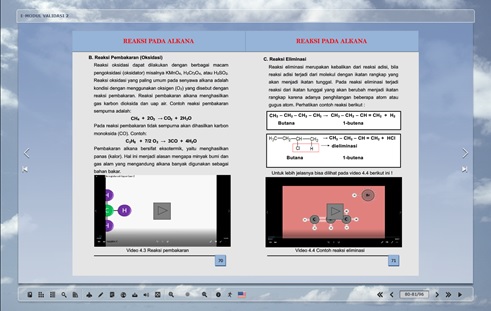
Implementation of Oriented Literated Science E-Module to Improve Critical Skills Thinking About in Hydrocarbon Material
Abstract
Keywords
Full Text:
PDFReferences
Citra, A. D., Yusran, K., & Maria, E. (2019). An Ethnoscience Study In Chemistry Learning To Develop Scientific Literacy. Jurnal Pendidikan IPA Indonesia, 8(2), 279-287.
Didit, A., & Bibin, R. (2016). Comparison of Students’ Scientific Literacy in Integrated Science Learning Through Model of Guided Discovery and Problem Based Learning. Jurnal Pendidikan IPA Indonesia, 5(1), 31-37.
Fatkhurrohman, A., & Retna, K. A. (2017). Pengembangan Modul Fisika Dasar I Berbasis Literasi Sains. Pancasakti Science Education Journal, 2(2).
Fengky, A. P., Sukarmin., Sarwanto., & Imam Sujadi. (2017). Development of E-module Combining Science Process Skills and Dynamics Motion Material to Increasing Critical Thinking Skills and Improve Student Learning Motivation Senior High School. International Journal of Science and Applied Science:Conference Series. 1(1) 45-54.
Fitria. H., & Julianto. (2018). Penerapan Literasi Sains dalam Pembelajaran IPA di Sekolah Dasar untuk Meningkatkan Kemampuan Berpikir Kritis Siswa dalam Memecahkan Masalah. Seminar Nasional Pendidikan.
Hake, R. R. (1999). Analyzing Change/Gain Scores, ARES-D American Education Research Association’s Devision.D. USA: Measurement and Reasearch Methodology.
Hartini, S., Misbah., Dewantara., Oktovian., & Aisyah. (2017). Development Learning Media Using Online Prezi Into Materials About Optical Equipments. Jurnal Pendidikan IPA Indonesia, 6(2,) 313-317.
Ika, R., Arif, H., & Sri, R. (2016). Analisis Keterampilan Berfikir Kritis Peserta didik SMP pada Materi Gaya dan Penerapannya. Prosiding Semnas Pend.IPA Pascasarjana UM, 1(2).
Karenann, J.,& Matthew, C. F. W. (2012). Science Literacy, Critical Thinking, and Scientific Literature Guidelines for Evaluating Scientific Literature in the Classroom. Journal of Geoscience Education, (60), 100-105.
Made. S., & Gusti, A. M. (2013). Pengembangan E-modul Berorientasi Pemecahan Masalah untuk Meningkatkan Keterampilan Berpikir Kritis Mahasiswa. Jurnal Pendidikan Matematika. 2(2).
Mai, L. Y., & Utiya. (2018). Development of Student Worksheet Science Literacy in XI Grade on Chemical Equilibrium Topic. Unesa Journal of Chemistry Education, 7(3), 308-314.
Maria, E., Rasmiwetti., Ellya, A., & Wahyudi. (2019). Efectiveness of Solubility Equilibrium Module Based on Lesson Study to Improve Critical Thinking Ability of Chemistry Students and Teachers in Senior High School Kampar District,Riau. Journal of Physics.
Maulana, A. W. K. A., & Sofia. (2014). Penerapan Model Pembelajaran Search Solve Create and Share (SSCS) untuk Meningkatkan Hasil Belajar Siswa XI IPA SMA. Jurnal Prndidikan Kimia, 1(1).
Miftahul, J., Jimmi, C., & Rasmiwetti, R. (2019). Development of Interactive Learning Media using Autoplay Media Studio 8 for Colloidal Chemistry Material, Journal of Educational Sciences, 3(1), 132-144.
Muhammad, N., Rizo B, P., & Riwayani, R. (2018). Design and Development of Physics Learning Media of Three Dimensional Animation Using Blender Applications on Atomic Core Material, Journal of Educational Sciences, 2(2), 23-32.
OECD. (2016). PISA 2015 Assesment and Analytical Framework; Science, Reading, Mathematic and Financial Literacy, Franch, OECD Publishing.
Serkan, S., & H, Ferhan Odabasi. (2009). Effects of an Online Problem Based Learning Course on Content Knowledge Acquisition and Critical Thinking Skills. Journal Computers & Education. 132-141.
Tuyuzsuz, C. (2010). The effect of The Virtual Laboratory on Students Achievement and Attitude in Chemistry. International Online Journal Of Education Scienses, (2), 37-53.
Vina, S., Sunaryo., Raihanati., I Made, A., & Inayati, J. S. (2018). Development of E-Module Based on Problem Based Learning (PBL) on Heat and Temperature to Improve Student’s Science Process Skill. The Turkish Online Journal of Educational Technology, 17(3).
Yenita, R., Putri, Y., Sehatta, S., Hadiyanta, A., & Andespa, S. (2017). Computer-Based Media for Learning Geometry at Mathematics Class of Secondary Schools, Journal of Educational Sciences, 1(1), 79-91.
Zulfahrin, U. Z., Haryono., & Sri. W. (2019). The Development of Chemical E-Module Based on Problem of Learning to Improve The Concept of Student Understanding. Innovative Journal of Curriculum and Education Technology. 8(2) 59-66.
DOI: http://dx.doi.org/10.31258/jes.4.2.p.347-356
Refbacks
- There are currently no refbacks.
Copyright (c) 2020 Bella Oktari, Susilawati Susilawati, Jimmi Copriady

This work is licensed under a Creative Commons Attribution 4.0 International License.
Publisher: FKIP Universitas Riau












